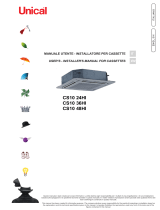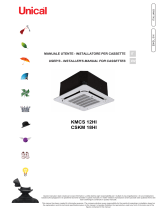2-4
! AVERTISSEMENT
Vérifier les points suivants au cours de l’installation.
• Ne pas installer l’appareil où il peut se produire des
fuites de gaz inflammable.
En cas de fuite et accumulation de gaz autour de
l’appareil, il y a risque d’incendie.
• S’assurer que le tuyau d’évacuation du condensat
est correctement branché.
Si le tuyau d’évacuation n’est pas correctement
branché, les éventuelles fuites d’eau risquent de
mouiller le mobilier.
• Ne pas surcharger l’unité (en fluide frigorigène).
Cet appareil est préchargé en usine. Une charge
trop importante risque de provoquer une surcharge
électrique ou d’endommager le compresseur.
• S’assurer que le panneau supérieur de l’appareil est
remis en place après l’installation ou l’entretien.
Avec un panneau mal fixé l’appareil va fonctionner
bruyamment.
• Les bords coupants et les surfaces du refroidisseur
tuulaire présentent un risque de blessure.
Mieux vaut éviter le contact avec ces endroits.
• Avant de couper l’alimentation électrique, veiller à
ce que l’interrupteur ON/OFF de la télécommande
soit en position “OFF” afin d’éviter une mise en
marche intempestive de l’appareil. Si l’interrupteur
de la télécommande n’est pas en position “OFF”, les
ventilateurs de l’appareil se mettront en marche dès que
l’alimentation électrique est rétablie. Il peut en résulter
un danger pour le personnel d’entretien ou l’utilisateur.
• Ne pas utiliser d’appareil de chauffage trop près du
climatiseur. Une chaleur excessive peut déformer ou
faire fondre le boîtier de plastic.
• S’assurer que la couleur des câbles de l’unité
extérieure et les marquages de bornes sont identiques
à ceux de l’unité intérieure.
•
IMPORTANT: NE PAS INSTALLER OU UTILISER
LE CLIMATISEUR DANS UNE BUANDERIE.
• N’utilisez pas de câbles joints et torsadés pour
l’alimentation électrique entrante.
• Évitez d’appliquer directement des produits de
nettoyage et de traitement pour bobines sur les
pièces en plastique. Une réaction chimique
pourrait se produire et déformer les pièces en
plastique.
• Pour tout renseignement concernant les pièces
détachées, contacter votre revendeur agréé.
! ATTENTION
• L’installation et la maintenance doivent être exécutées
par une personne qualifiée qui est familiarisée avec les
lois et réglementations en vigueur, et aussi expérimentée
dans ce type d’équipements.
• Tous les câblages doivent répondre aux réglementations
électriques nationales.
• Avant de commencer le raccordement suivant le schéma
électrique, s’assurer que la tension nominale de
l’appareil corresponde bien à celle indiquée sur la plaque
signalétique.
• L’ unité doit être raccordée à la TERRE pour prévenir
tous les risques possibles dûes à un défaut d’isolation.
• Les fils électriques ne doivent en aucun cas être en
contact avec les tuyaux de réfrigérant ou les parties
mobiles des moteurs du ventilateur.
• Avant l’installation ou l’entretien du climatiseur,
s’assurer que l’appareil est éteint (OFF).
• Débrancher l’appareil du circuit d’alimentation secteur
avant de procéder à l’entretien du climatiseur.
• NE PAS retirer le câble d’alimentation électrique de la
prise quand l’appareil est sous branché. Il peut en résulter
des décharges électriques importantes susceptibles de
provoquer un incendie.
• Les unités intérieures et extérieures, le cordon
d’alimentation et le câblage de transmission doivent
rester à une distance d’au moins 1 m des téléviseurs et
des radios, ce afin d’éviter les images déformées et les
parasites. (En fonction du type et de la source des ondes
électriques, des parasites peuvent être entendus même
avec une distance supérieure à 1 m).
PRÉCAUTIONS DE SÉCURITÉ
Ce manuel fournit les procédures d’installation pour assurer le bon fonctionnement et la sécurité de cet appareil.
Des ajustements peuvent être nécéssaires pour suivre les réglementations locales.
Avant d’installer et de faire fonctionner le climatiseur, lisez attentivement ce manuel et conservez le.
Cet appareil est destiné à être utilisé par des utilisateurs experts ou formés dans les magasins, dans l’industrie
légère ou dans les fermes, ou pour un usage commercial par des personnes non spécialisées.
MANUEL D’INSTALLATION
AVIS
Instructions d’élimination
Cet appareil de conditionnement d’air porte le symbole ci-joint. Ce symbole signifie que les appareils électriques
et électroniques doivent être éliminés séparément des ordures ménagères non triées.
N’essayez pas de démonter vous-même l’appareil : le démontage de l’appareil de conditionnement d’air ainsi
que le traitement du réfrigérant, de l’huile et d’autres composants doivent être effectués par un installateur
qualifié, en accord avec les réglementations locales et nationales en vigueur.
Les appareils de conditionnement d’air doivent être traités dans des installations spécialisées de dépannage,
réutilisation ou recyclage. En vous assurant que cet appareil est éliminé correctement, vous contribuez à
éviter les conséquences potentiellement néfastes sur l’environnement et la santé. Veuillez contacter votre
installateur ou les autorités locales pour plus d’information.
Les piles de la télécommande doivent être enlevées et éliminées séparément, conformément aux réglementations
locales et nationales en vigueur.
2 5CKYCR-0709 FR 2/5/10, 1:38 PM4






















